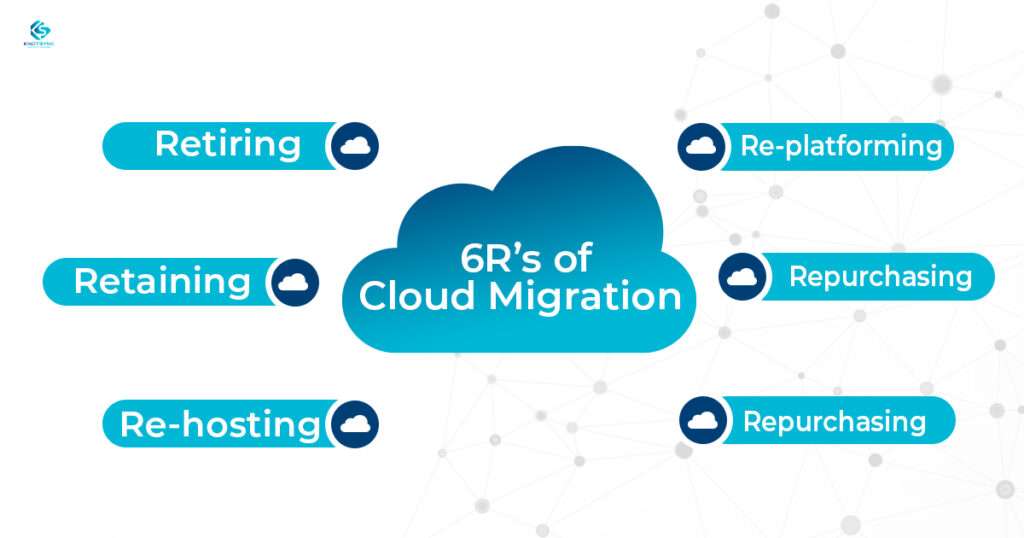What Is a Cloud Migration Strategy?
Cloud migration strategy is a very important business approach to handle and manage the business resources, applications and data that are fragmented or duplicated across different locations. Cloud migration strategy helps you in overall data center strategy. With cloud migration, you can avoid crucial data disasters.
If your organization has not begun its cloud journey, it’s time to start planning how you will use the cloud, when and for what purposes. Also, in order to achieve successful migration of your company’s data, assets and applications to the cloud you’ll need to determine if using multiple clouds is right for your business, whether the public cloud or private cloud model makes more sense.
Let’s look at 6R’s of cloud migration that help you successfully migrate to the cloud.
The 6R’s of Cloud Migration

- Retiring: The first R is retiring the existing infrastructure. Once you decide to retire the existing infrastructure and move it to the cloud, you’ll need to make a number of choices about how to move everything forward. Retiring can be a complex process, especially if you’re moving data across multiple locations. So, you’ll need to consider how much data needs to be moved, how long it will take and what kind of connection you have at each site.
- Retaining: Retaining the existing IT environment and legacy applications while moving to the cloud is a common method used by businesses. Retaining legacy applications can improve productivity, increase efficiency and help you avoid breaking systems during a migration.
- Re-hosting: Re-hosting to the cloud is moving your existing server applications and data over to a cloud environment. Rehosting is required for any application that requires a custom hosting environment, as well as for multi-tenant applications that require complete isolation from other tenants on the network.
- Re-platforming: Re-platforming your entire business to a new cloud provider can deliver significant benefits like saving time and cost. It also allows you to move on from legacy technology which is no longer meeting your needs, and may not be practical for further development, to a modern and scalable infrastructure that supports the future growth of your business.
- Repurchasing: The repurchasing cloud migration strategy allows you to keep your existing infrastructure, while moving it to a new vendor. This is an ideal scenario if you want to repurchase only what you need of your existing VMInstance or start fresh with the use of a fresh VMware license.
- Refactoring: Refactoring is an important step in the process of cloud migration to improve code quality without changing its functionality. You basically need to refactor before you migrate your application because migrating the old, bad code becomes more difficult and time-consuming.
These 6R’s of cloud migration can be used to plan out the migration process and reduce risks in various ways. However there a few challenges that business face if they don’t plan out the migration process carefully. Let’s talk about the challenges now.
Why Is Cloud Migration Crucial for Businesses?
In order to remain competitive in today’s tech-heavy market, it is important to research and implement new technology quickly. Businesses need to move faster than ever in order to satisfy a demanding customer base. Yet many of them are standing still—or even underperforming in the cloud given the old habits and legacy thinking.
Only those businesses that are continually looking for ways to innovate can compete and stay relevant in the online marketplace. The coming of cloud technology has provided such organizations with the means to expand their capabilities and make better use of their resources.
So, cloud migration strategy is crucial for businesses as it helps organizations to understand their cloud adoption and migration needs, optimize the existing infrastructure and achieve their goals. In this way, a successful cloud migration strategy can help organizations realize higher levels of efficiency, agility and cost savings in the long run. Moving to the cloud offers a lower cost because you don’t need to buy and maintain hardware, software licenses and other IT equipment.
Today, businesses plan to manage risk and plan for the future by embracing the cloud. Many companies aim to cut costs while improving productivity and efficiency by minimizing or eliminating capital investments in infrastructure. Cloud migration also increases security and availability of data, services, applications and desktops.
Challenges of Cloud Migration
There are many major roadblocks in the path of cloud migration that must be overcome before organizations can realize its full benefits. The transition from on-premise to cloud can present a wide range of challenges depending on your business and its needs. The challenges of your cloud migration strategy include the need to plan for all the new apps, services and data that will be housed in the cloud. Since, cloud migration strategy is not a one-size-fits-all process, it has to be altered according to business requirements and company infrastructure. Let’s look at some common challenges of cloud migration:
1. Lack of Planning
For every business, the cloud migration strategy should be a well thought out plan to build a robust, secure infrastructure that supports your business and IT goals. This is important because without a concreate plan, you can’t build a sustainable and successful solution for your company. So, businesses should build a proper strategy with their IT support provider before the migration occurs.
2. Data Security and Compliance Risks
Data security and compliance risks are one of the biggest challenges that companies face when migrating to cloud computing. By using a single, secure cloud platform, you can keep all your data in one place—which means everything you need to ensure compliance is available 24/7, wherever you need it.
3. IT Support Provider
One of the biggest challenges in a cloud migration is deciding on the right IT support provider. Choosing the right provider means ensuring that your business can move, change and grow without restriction. Moving to the cloud without this freedom will stifle innovation and growth. Get in touch with our IT support team and get the IT support you need to work efficiently.
Final Words
Following a cloud migration strategy is one of the most important decisions you will ever make for your company. Not only does it provide flexibility and scalability, it also makes it easier to collaborate with other departments. Cloud migration will prove to be a strategic move that will allow you to use the most up-to-date versions of products, thus making your business more efficient and agile. What are you waiting for? Choose cloud migration today and step towards the new era of technology.



